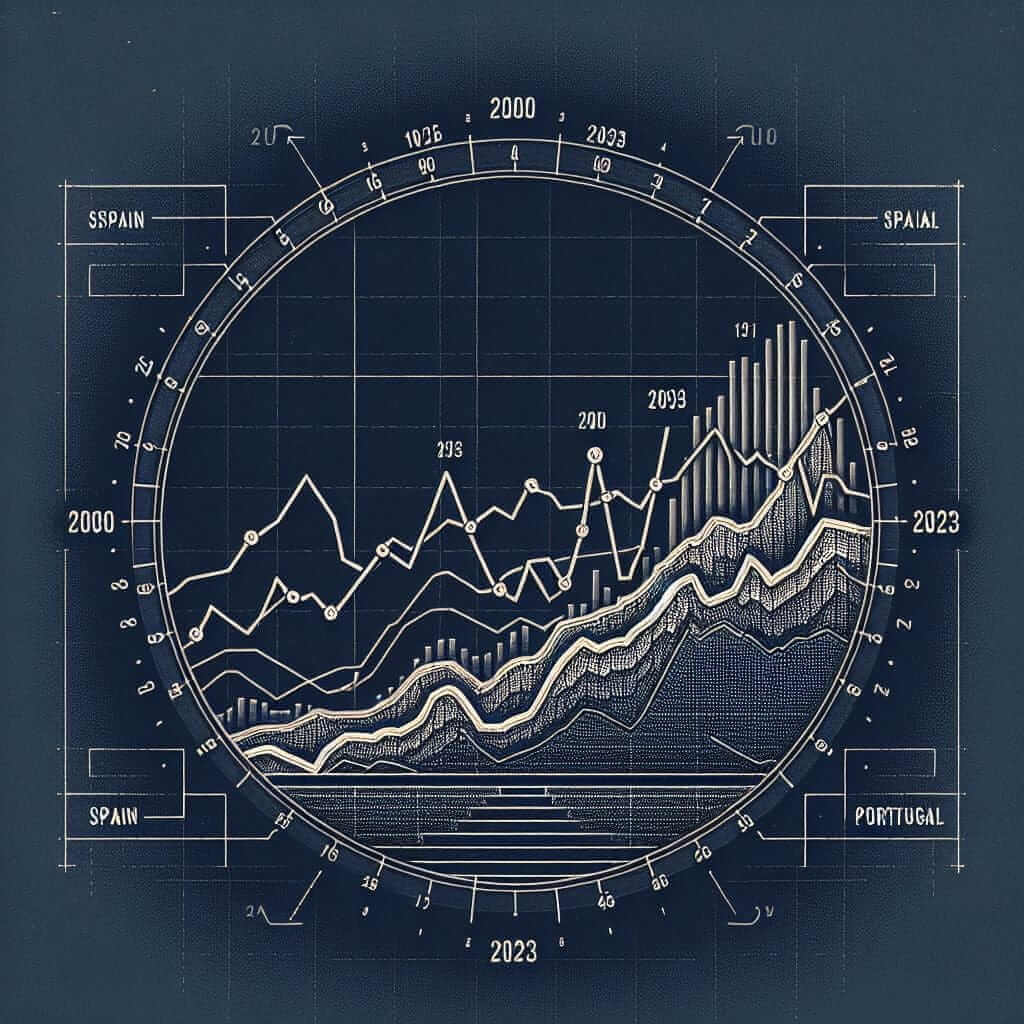In the realm of IELTS Writing Task 1, candidates are often tasked with analyzing and summarizing visual data, including charts depicting trends in unemployment rates. The Iberian Peninsula, particularly Spain and Portugal, has witnessed significant fluctuations in unemployment figures over the past two decades. This article delves into the intricacies of comparing Spain and Portugal’s unemployment rates, equipping you with the necessary tools to master this type of IELTS task.
To illustrate, consider these potential IELTS Writing Task 1 questions:
- The line graph below shows the unemployment rates in Spain and Portugal between 2000 and 2023. Summarize the information by selecting and reporting the main features, and make comparisons where relevant.
- Analyze the provided chart illustrating the percentage of unemployed individuals in Spain and Portugal from 2000 to 2023. Write a report for a university lecturer, highlighting the key trends and making comparisons where appropriate.
- The following line graph compares the unemployment figures for Spain and Portugal over a 23-year period (2000-2023). Write a report describing the information presented in the graph.
Sample IELTS Writing Task 1 Question
Let’s focus on the following question and provide a sample response:
The line graph below shows the unemployment rates in Spain and Portugal between 2000 and 2023. Summarize the information by selecting and reporting the main features, and make comparisons where relevant.
(Insert line graph depicting unemployment rates in Spain and Portugal from 2000 to 2023. Data can be sourced from reputable sources like the World Bank or Trading Economics).

Data Analysis
The line graph illustrates the fluctuations in unemployment rates for both Spain and Portugal between 2000 and 2023.
Overall Trend:
- Both countries experienced periods of economic growth and contraction, reflected in the fluctuating unemployment figures.
- Spain consistently exhibited higher unemployment rates compared to Portugal throughout the period under review.
Key Features:
- Early 2000s: Both countries enjoyed relatively low unemployment rates, with Spain hovering around 10% and Portugal around 7%.
- Financial Crisis (2008-2013): The global financial crisis significantly impacted both nations. Spain’s unemployment rate skyrocketed to nearly 27% by 2013, while Portugal experienced a more gradual increase, peaking at around 18% in 2013.
- Recovery and Recent Years: Post-crisis, both countries witnessed a gradual decline in unemployment. However, Spain’s recovery was slower, and its unemployment rate remained significantly higher than Portugal’s. By 2023, Spain’s unemployment rate had fallen to approximately 13%, while Portugal’s stood at around 6%.
Model Answer
The provided line graph presents a comparative overview of unemployment rates in Spain and Portugal between 2000 and 2023. Overall, both countries experienced fluctuations in unemployment levels, with Spain consistently exhibiting higher figures than Portugal.
At the dawn of the millennium, both nations enjoyed relatively favorable unemployment rates, with Spain at around 10% and Portugal at 7%. However, the global financial crisis of 2008 had a dramatic impact. Spain’s unemployment rate surged to nearly 27% by 2013, whereas Portugal’s rate peaked at a comparatively lower 18% during the same period.
The post-crisis years witnessed a gradual recovery in both economies. However, Spain’s unemployment rate declined at a slower pace, remaining significantly higher than Portugal’s. By 2023, Spain’s rate had fallen to approximately 13%, while Portugal’s stood at a much lower 6%.
In conclusion, while both Spain and Portugal experienced economic challenges reflected in their unemployment rates, Spain faced more severe impacts from the financial crisis and exhibited a slower recovery in subsequent years.
(Word count: 176 words)
Writing Tips
- Paraphrase the question: Avoid simply copying the question wording in your introduction.
- Focus on trends: Identify the main trends and patterns in the data.
- Use data selectively: You don’t need to report every data point. Focus on significant changes and comparisons.
- Use appropriate vocabulary: Employ a range of vocabulary related to trends, comparisons, and data interpretation.
- Accurate grammar and punctuation: Ensure your writing is grammatically correct and well-punctuated.
Vocabulary
- Skyrocket (verb): To increase rapidly and suddenly.
- Surge (verb): To increase suddenly and powerfully.
- Plunge (verb): To decrease rapidly and suddenly.
- Fluctuation (noun): An irregular rising and falling in number or amount.
- Gradual (adjective): Happening slowly over a period of time.
- Exhibit (verb): To show something clearly.
- Consistently (adverb): In a way that does not change.
- Comparatively (adverb): In a way that invites comparison with something else.
- Favorable (adjective): Giving you an advantage or more chance of success.
- Subsequent (adjective): Happening after something else.
Conclusion
Mastering IELTS Writing Task 1 involves understanding data trends, making accurate comparisons, and using appropriate vocabulary. By analyzing sample questions and practicing your writing skills, you can enhance your ability to effectively summarize and report visual information, ultimately boosting your IELTS band score. Remember to focus on clarity, conciseness, and accuracy in your writing.